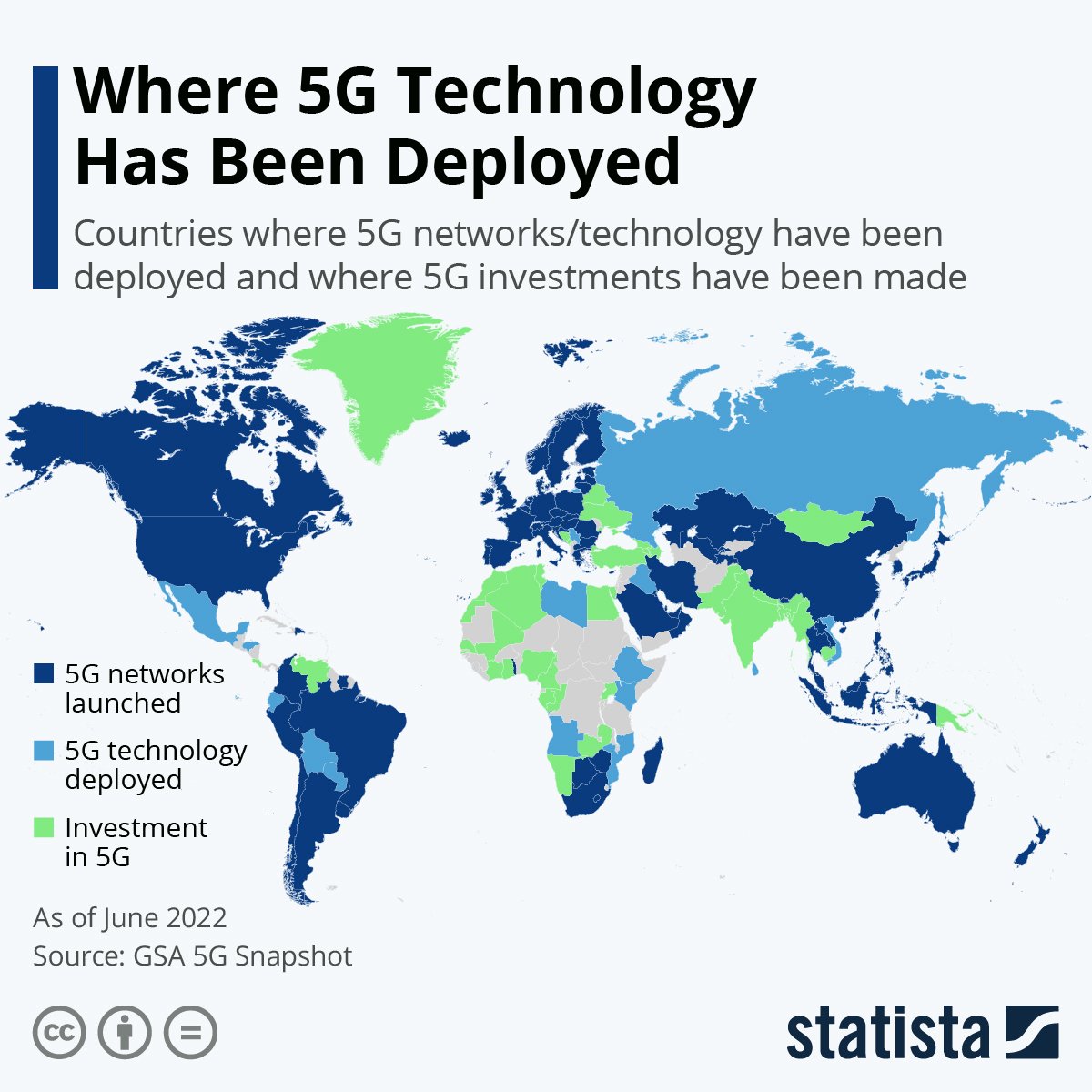Telecommunications leaders say 6G wireless tech could be available in 2030 … just seven years from now.
Each generation of technology is built upon the previous one, with more capabilities opening up with each iteration.
To grasp where we’re headed in internet speeds and data communications, we must first understand where the current 5G deployment stands and examine 5G Advanced.
Most of us are familiar with 5G, with about 80% of the U.S. population having access to it.
 You will find more infographics at Statista
You will find more infographics at Statista
5G is the latest rollout of connective technology – built to replace 4G – using cellphone towers to send internet to your home. 5G providers operate like traditional internet service providers (ISPs) and can offer speeds up to 1,000 Mbps in some areas.
Don’t fret, though. 4G isn’t going anywhere anytime soon, “the plan is for existing 4G LTE networks to be used by carriers well into 2030,” said RCI Wireless Control.
5G home internet
5G home internet is a growing space, with Verizon, T-Mobile and Starry leading the way. 5G allows data to transfer from a source to its destination faster and with fewer delays. It can be applied to cellphones, which most people likely think of when they hear the term, as well as home internet.
Your 5G home internet connection depends on how close you are to your provider’s cell towers or nodes.
5G Advanced
“5G-Advanced will offer 20% higher data rates compared to 5G,” as well as improved latency, according to Nokia researchers.
5G Advanced will enhance the current 5G capabilities by paving the way for more artificial intelligence (AI) advancements and significantly improving live video feeds.
“By improving the 5G standards to allow for better device-network cooperation, the full potential of 5G Advanced can be realized. This next step in the evolution of cellular wireless access is set to open up new possibilities for service providers, paving the way for 6G,” reports Ericsson.
What will 6G look like?
As Nokia explains, “The 5G era has turned its focus on connecting the Internet of Things (IoT) and industrial automation systems. In the 6G era, the digital, physical and human world will seamlessly fuse to trigger extrasensory experiences. Intelligent knowledge systems will be combined with robust computation capabilities to make humans endlessly more efficient and redefine how we live, work and take care of the planet.”
Think about how far we’ve come from 3G and 4G connectivity. We now have smart cities, farms, transportation, advanced robotics, etc.
6G will take those operations to the next level. Nokia says that “energy efficiency will be a major design criterion in 6G along with the other metrics such as capacity, peak data rate, latency, and reliability.”
Faster internet and more
With 6G your internet connection will be faster and more stable, happening in real-time.
But that’s not all. 6G will be a “broad platform for innovation and the information backbone of society,” reports Ericsson.
When a new tech comes along, often our devices need to be replaced to use it. Ericsson says that won’t be an issue with 6G, as devices will be future-proofed with more programmability and advanced interfaces.
![]()
Future services will require connectivity everywhere and in everything. 6G networks can support trillions of embeddable devices and provide trustworthy connections that are available all the time.
Think about your workplace. You may already have some AI or virtual reality (VR) components, but 6G will enhance those to make communications instantaneous.
For example, as reported by Forbes, “Aerospace and engineering conglomerate Honeywell is already using AR and VR to improve its training efforts. The company equips new hires with mixed reality headsets and enables them to ‘see’ the work other employees are doing. As the new hires mimic the tasks, the VR and AR technology overlays information that guides them as they learn.”
6G will bring a whole new world to internet users, not just in speed but in how we interact with others.
Ericsson foresees “4D maps of whole cities that are precise in position and time and can be simultaneously accessed and modified by large numbers of humans” and machines like self-driving vehicles.
We can walk through our friends’ homes and visit with them in real-time while we are physically thousands of miles away from them.
This next platform will affect how we interact in every aspect of our lives: Commerce, infrastructure, education, health and work.
Written by:
Robin LaytonEditor, Broadband Content
Robin Layton is an editor for the broadband marketplace Allconnect. She built her internet industry expertise writing and editing for four years on the site, as well as on Allconnect’s sister site MYMOVE.com. …
Read more

Edited by:
Camryn Smith-
Featured
![Report: Internet users are gobbling data by more than a half-terabyte]() Report: Internet users are gobbling data by more than a half-terabyte Robin Layton — 4 min read
Report: Internet users are gobbling data by more than a half-terabyte Robin Layton — 4 min read -
Featured
![ACP program allows eligible households to get high-speed internet for free]() ACP program allows eligible households to get high-speed internet for free Robin Layton — 2 min read
ACP program allows eligible households to get high-speed internet for free Robin Layton — 2 min read -
Featured
![Best gigabit modems of 2024 compared]() Best gigabit modems of 2024 compared Camryn Smith — 5 min read
Best gigabit modems of 2024 compared Camryn Smith — 5 min read
Latest
-
Wednesday, April 24, 2024
Why do you need an Optical Terminal Network?Taylor Gadsden — 2 min read
-
Tuesday, April 23, 2024
Worried about losing your TV signal? This is how to keep your satellite dish cleanDavid Anders — 6 min read
-
Tuesday, April 23, 2024
How to change your Wi-Fi network passwordCamryn Smith — 2 min read
For researchers and journalists
If you would like to know more about this topic, we can assist you. Our experts can help you dig deeper into the data.
Email our experts





